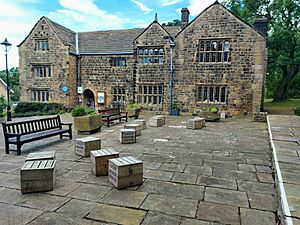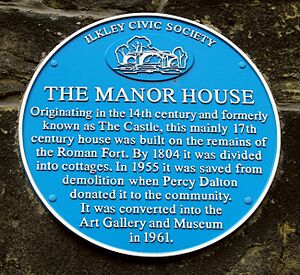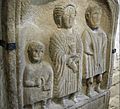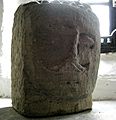Ilkley Manor House facts for kids

The front or south-facing side of Ilkley Manor House, Ilkley, with a view of the Castle Yard courtyard.
|
|
| Former name | Manor House Museum and Art Gallery |
|---|---|
| Established | 1961 |
| Location | Castle Yard, Ilkley, West Yorkshire, England LS29 9DT |
| Type | Heritage centre, Historic house museum, Interpretation centre, Art gallery |
| Public transit access | Ilkley railway station; Ben Rhydding railway station |
Ilkley Manor House is a special place in Ilkley, West Yorkshire, England. It is a museum, an art gallery, and a place for live events. The museum opened in this building in 1961. Its main goal was to save old archaeological items from the area. Many Roman artifacts were being lost as the town grew.
For a long time, Bradford Council managed the Manor House. But in 2013, it had to close because there wasn't enough money. To keep it open for everyone, a group called the Ilkley Manor House Trust was created. In April 2018, Bradford Council gave the Manor House and three nearby cottages to the Trust. This meant the community could now run it.
Contents
The Museum's Early Days
Before the museum moved to Ilkley Manor House, it had an interesting history. Here are some important moments:
- 1892: A museum was started by a group called the Museum Committee. This was very important because the town of Ilkley was growing fast. This growth was disturbing Roman and other old remains underground. People said that Roman items were being taken away in cartloads. Local historians tried to save these artifacts, but they had nowhere to show them. The committee first wanted the building that is now the Manor House, but it was too expensive. So, they bought an old chapel built in 1834. The museum opened on August 25, 1892. The first person in charge, called the curator, was Herbert Oxley. Soon after, it was renamed the Ilkley Museum and Antiquarian Society.
- 1893: The first things on display included local rocks and plants. There were also drawings of old stones with Neolithic or early Bronze Age carvings. Roman items, like a triple vase, were also shown. They even had things belonging to a local musician known as Blind Jim.
- 1896: The Ilkley Urban District Council took over the museum. Herbert Oxley passed away, and his wife became the new curator.
- 1908: The museum moved to the top floor of the new Public Library. William Graham became the curator and stayed in that job until 1942.
- 1922-1928: The museum received many donations, but it didn't have enough space. It had too many items that weren't from the local area. This made it hard to organize and display the important Roman artifacts. Some non-local items were returned or sold to other museums. The museum kept things like photos of local people, old coins, and Anglo-Saxon cross carvings. It also had a famous Roman triple vase and even Japanese armour.
- 1939–1948: During World War II, the museum's exhibits were packed away. This made room for wartime offices. The curator, William Graham, died, and no one replaced him. Many items got mixed up or went missing while in storage.
- 1949: The museum reopened on June 4, 1949, as Ilkley Museum. Grace Simpson helped get everything back in order, and Elsie Fletcher became the Honorary Curator.
- 1954: Elsie Fletcher started a group called the Olicana Museum Society. This group later became the Olicana Historical Society. It still exists today and focuses on local history and archaeology.
- 1955–1961: The Old Castle, which is the current Manor House building, became available. It was almost going to be torn down. It needed a lot of money and work to change it from several small cottages into one building. With help from the local council and a government grant, the Manor House Museum and Art Gallery opened on July 8, 1961.

Ilkley Manor House Since 1961
Here are some important things that have happened at Ilkley Manor House since it became a museum and art gallery in 1961:
- 1961–1974: The old building itself became a main part of the museum. By 1963, the two upstairs rooms were art galleries. Arthur Kitching became the second curator. He was also an artist and showed his own work there.
- 1963: A group called the Friends of the Manor House was formed to support the museum.
- 1974-1977: The people who looked after the building used to live upstairs. But their rooms were changed into offices. Also in 1974, the Manor House joined the Arts and Museums Division of the Bradford Metropolitan District. This helped the museum get some lost exhibits back and share resources with other museums. In 1977, Arthur Kitching stopped being the curator.
- 2013: Bradford Metropolitan District Council announced that it could no longer fund Ilkley Manor House. A group started a campaign to save the House from closing.
- 2016: The Ilkley Manor House Trust was officially created.
- 2017: Bradford Council agreed to transfer the Manor House to the Trust. This meant the community could run it.
- 2018: After being closed for five years, Ilkley Manor House reopened. The famous gardener and TV presenter, Alan Titchmarsh, helped open it.
- 2021: The Friends of the Manor House group was no longer active.
- 2022-Present: In early 2022, the Manor House started a Supporters' Scheme. Also, the two Verbeia altar stones (the original Roman one and a copy from 1608) were moved to be displayed together in the Heritage Room.
What You Can See Today
Most of the local historical items are now in the Heritage Room. This room is on the ground floor of the solar wing. You can see items from the Stone Age (Neolithic period), Roman times, and the Middle Ages. There are also things from Victorian, Edwardian, and more recent years.
-
The original Roman altar on the left and the 1608 replica on the right. The original is dedicated to the goddess of the River Wharfe, Verbeia.
-
Neolithic arrowheads
-
Gritstone bas-relief tombstone of Romano-British woman Vedica, who died aged 30.
-
Sandstone bas-relief of Roman family.
-
Anglo-Saxon carved sandstone blocks.
-
Oak bench from home of Thomas Chippendale, possibly made by him or his father.
-
Oak bench from home of Thomas Chippendale, possibly made by him or his father: closeup.
The Manor House Building
The Manor House building itself is very old and interesting. It is the oldest house in Ilkley. It was built near All Saints' Parish Church on the site of a Roman fort called Olicana. The church was built in Anglo-Saxon times on top of the fort's headquarters. The Manor House was built into the fort's western defenses. This means part of the old Roman fort wall is now part of the building. You can still see many small Roman stone blocks in its walls.
Before it became a museum, Ilkley Manor House was known as 'The Castle'. This name probably came from the Roman fort, which was called a castrum. The House also has signs of a Peel tower, which is a type of small castle tower. This might also explain the name 'The Castle'. However, the building was likely not used as a fort itself.
The front of the building faces south. The left side, or west wing, now has a buttery (a room for food) and a storeroom. This part is partly from the Middle Ages. It was built on the Roman fort wall. The doorways inside this wing have special arches from the 14th century. The windows with stone dividers are from the 17th century. The central part of the roof covers the main eating hall, which has a fireplace. The right side, or east wing, is called the solar wing. This part had rooms upstairs for the owner, with a toilet and a fireplace. The top floor of the solar wing is now the Solar Art Gallery. The front walls and windows of the main hall and solar wing are from the 16th century. The front doorway with a pointed arch might be from the late Norman period.
The back of the building faces north. It is partly built with stones taken from the Roman fort. The passage doorway might be from the Middle Ages. But the archway and the right (west) wing are from the 17th century. The wall under the central and east parts of the roof on this side is from the 15th to 16th century. The lowest large window in the solar wing on this north side is from the 17th century. Other windows on the north side are more modern.
Inside the roof of the solar room, you can see the strong wooden structure. This structure, with its main posts and beams, was built in the 15th or 16th century. It forms the main frame of the roof, like a series of strong triangles.
Learning at the Manor House
The Manor House is also used for learning. The Heritage Room on the ground floor is a popular spot for local schools. Children visit to learn about the history of the area. They often learn about Roman British history, as this fits with their school lessons.
At the House, kids can discover:
- The remains of the Roman fort.
- What life was like for a Roman soldier in Britain. They can even see a copy of a Roman helmet.
- The Roman military campaigns.
- How the fort and the nearby civilian settlement worked.
Visitors can also read two new information boards outside. One board, "Discover the History of the Roman Fort," is near the Roman wall. It talks about when the Romans lived there. The second board, "Journey Back in Time," is near the Northern Gate Marker. It describes what life might have been like in the past.
See also
- Grade I listed buildings in West Yorkshire
- Listed buildings in Ilkley
- List of museums in West Yorkshire














